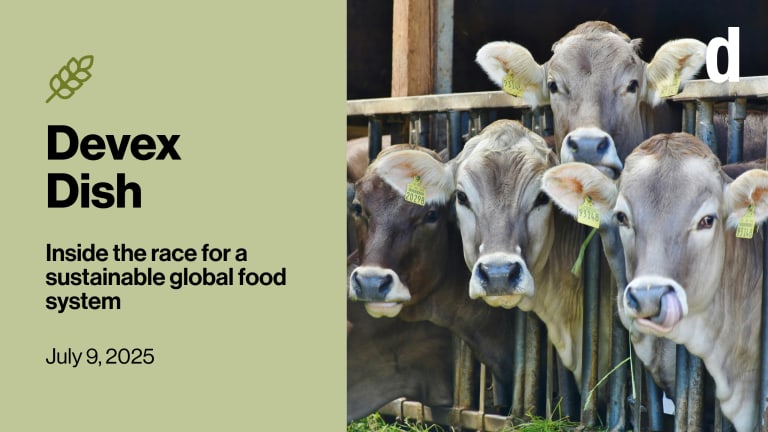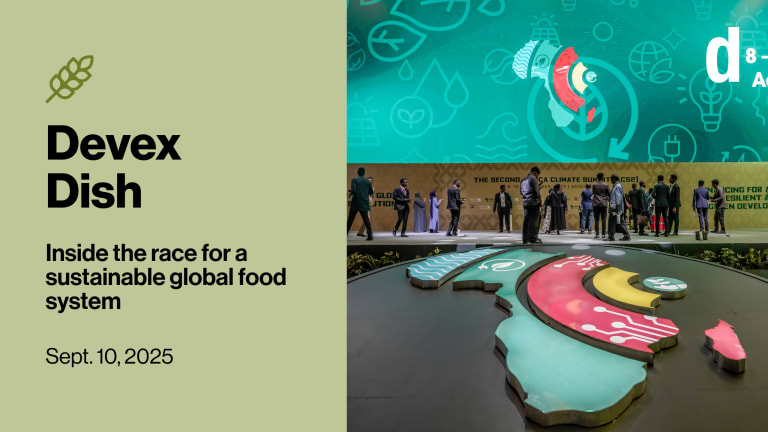
When it comes to avian influenza, the threat is in the name. Except it turns out that the risks extend beyond birds – and not just because the disease is showing a propensity for crossing over into other species.
The current outbreak is centered in the United States, where the strain — known as H5N1 — is rapidly spreading and has infected dairy cattle, which then shed it in their milk. (For the record, scientists agree that pasteurized milk is safe to drink.) The virus has appeared in at least 101 cattle herds, although that number is probably low as farmers resist testing their cattle out of fear they might be forced to stop production.
This is a preview of Devex Dish
Sign up to this weekly newsletter to get the inside track on how agriculture, nutrition, sustainability, and more are intersecting to remake the global food system.
Experts agree that the U.S.-based outbreak hasn’t had any impact on global food distribution or nutrition. But as avian influenza spreads beyond just poultry to other livestock populations, it got us thinking: What might be some of the potential implications of an avian flu outbreak for global food systems, particularly in lower-income settings?
The standard response to an outbreak of bird flu is to cull the affected population, which, if the disease has spread far enough, can lead to shortages in poultry and eggs that are vital sources of animal protein for some communities. Last year in South Africa, outbreaks of two strains of avian influenza forced officials to kill 7.5 million chickens, sending the price of poultry and eggs skyrocketing.
To prevent future outbreaks and limit these and other risks, experts are pushing for renewed attention to a “One Health” approach, which recognizes that environmental health, animal health, and human health are all interlinked.
“The concept of One Health had become the global slogan during the first round of [avian flu] outbreaks in the early 2000s,” Robyn Alders, a veterinarian and One Health expert at the Australian National University, tells me. “But we haven’t really managed to nail down the implementation, what does it mean, and how do we deal with that significant resource inequity.”
That resource inequity is where things could get dicey with a microbe that knows no country borders. A One Health approach could limit outbreaks, and it begins with stricter surveillance and quickly alerts experts across the wildlife, climate, and public health sectors — though it will require funds that lower-income settings may not have, says Madhur Dhingra, the senior animal health officer at the Food and Agriculture Organization.
Read: Bird flu outbreak highlights potential risks to global food security
Future planning
ICYMI, leaders of the Group of Seven advanced economies unveiled a new initiative to help “overcome structural barriers to food security and nutrition” with a focus on Africa at their annual gathering last week. But it seems they did not consult many of the people on the continent that the plan would benefit.
The G7 Apulia Food Systems Initiative, named for the Italian region that hosted this year’s summit, aims to help build resilient sustainable and productive agricultural and food systems while ensuring everyone can progressively realize the right to adequate food. And it wants to achieve this while making agrifood systems climate-friendlier, a joined-up approach that drew praise from observers. The specifics are still to be worked out by the development ministers of the G7 countries, even as the G7 communiqué called on them to pay special attention to plans that African leaders already have in place for upgrading agrifood systems on that continent.
Except the people meant to benefit from this plan, particularly African farmers, say no one really talked to them about it beforehand. Nga Célestin, permanent secretary of the Regional Platform of Farmers' Organizations in Central Africa, or PROPAC, called the plan “half baked,” and said it would only work if the G7 “get more finance to small-scale producers and their organisations, or invest in the diverse and nature-friendly practices needed to reduce emissions and adapt.”
In a press release, his organization also pointed out that the plan does not seem to bring in new money, which has them questioning how serious the G7 is about impact.
The initiative builds off of an Italian plan that aims to spur development in Africa hoping that will help curb immigration from the continent to Europe. That plan includes a broader focus on education and training, health, water, and energy, along with agriculture.
Striking a balance
Bringing home the bacon
Your next job?
Afar Regional Food Systems Advisor
FHI 360
Ethiopia
Among the guidance coming out of Africa that the G7 leaders promised they would consider were the pledges from the Africa Fertilizer and Soil Health Summit last month. Those included a promise by the African Union to triple fertilizer use on the continent over the next decade in a bid to improve soil that has been overused and harmed by climate change.
In an opinion piece for Devex, Henk van Duijn, the president of the International Fertilizer Development Center, writes that there is a need to balance how and what fertilizer is used, including organic and chemical fertilizers. IFDC looks to alleviate global hunger by improving sustainable agriculture productivity.
Fertilizer use has been controversial on the African continent. There was a recognition of the importance of soil health at the recent conference, van Duijn writes, which was progress — and underscores “the need for a holistic approach to agriculture that nurtures soil vitality,” he writes. While indiscriminate or unbalanced use of minerals should be discouraged, “organic sources of fertilizer alone cannot give crops the nutrients they need for optimal growth,” he adds.
Instead, he advocates for a multipronged approach that involves using soil testing to provide farmers with data-driven fertilizer guidance, bolstering the understanding of optimal nutrient management practices, and ushering in policies and market reforms that will make appropriate fertilizers more widely available.
Opinion: Balanced fertilizer use is essential to agriculture in Africa
Background reading: African leaders pledge to triple fertilizer use to improve soil quality
From our archives: Mineral fertilizers ‘here to stay,’ says IFDC (Pro)
+ A Devex Pro membership brings you exclusive in-depth reporting and analyses, data-driven funding insights, invite-only events, and access to the world’s largest global development job board. Get these perks and more by signing up for a 15-day free trial.
Number munching
38%
—That’s the percentage of the $56.7 billion in humanitarian appeals in 2023 that was actually secured.
This budget shortfall comes in the midst of an unprecedented hunger and nutrition crisis, World Vision explains in a new report, including 45 million children under age 5 affected by wasting. But when funding needs aren’t met, it forces relief agencies to ration their services and only focus on those most urgently in need, with devastating consequences.
World Vision’s Global Hunger Response team surveyed people affected by humanitarian crises in six countries to find out how they have been impacted by reductions in emergency food and cash assistance. Among their findings:
• Most children who had previously eaten two meals a day were down to one or zero.
• The cuts are pushing families into debt or forcing them to take on more work.
• Ration cuts are exacerbating health problems, including malnutrition and waterborne diseases.
• The cuts are also creating a mental illness crisis.
Related reading: What are the most and least funded humanitarian appeals of 2023? (Pro)
Chew on this
A new high-level platform unveiled at the Paris Peace Forum is looking to bring together stakeholders, including international organizations, development banks, foundations, and civil society, to mobilize agricultural development in Africa. [Devex]
With the help of good weather and pesticide and fertilizers, Ghana — the world’s second-largest grower of cocoa — expects its crop to recover next season. [Bloomberg]
What was actually accomplished at the United Nations midyear climate talks in Bonn? Experts warn that too many issues were left unresolved. [Devex Pro]
Over the past decades, Asian grocery stores, like H Mart and Patel Brothers, have emerged from mom-and-pop shops in suburban strip malls to multibillion-dollar companies. [The New York Times]








